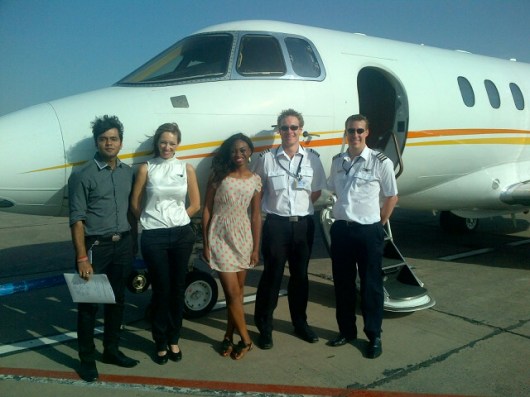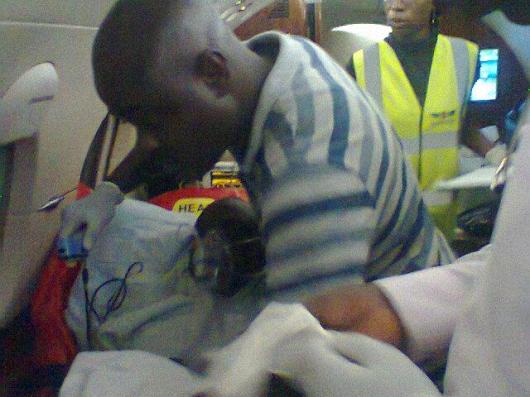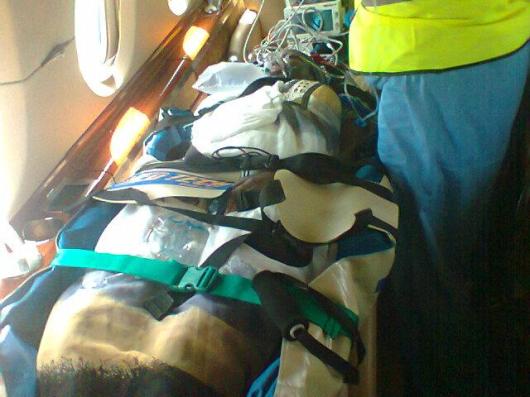
How did you end up running an air ambulance in Nigeria?
I’ve been very interested in emergency trauma medicine since the beginning of medical school. And I love the fact that all over the United Kingdom, where I grew up, there are air ambulance services — I think about 20 in all — that serve rural communities as well as urban communities, making sure that people get to hospital within the right time frame. In our tiny town, Lowestoft, we don’t even have a hospital. The nearest one is Norwich. It takes about 45 minutes to get a hospital by road, but by air it takes 5 to 10 minutes.
When my sister became very, very ill on holiday with relatives in Nigeria, the hospital was unable to manage her condition. My family and I started to search for an air ambulance. We searched in Nigeria, there was none. Ghana, none. Sierra Leone and Cameroon, none. In fact, there was none within the whole of West Africa. So we looked in South Africa, which is five hours away. We finally found one, but they said they’d take just under two days to get to Nigeria. And by the time we’d organized all the logistics around that, my sister was dead. She didn’t die because her condition was unmanageable; she died of a condition that I could have managed with the medicines in the cupboard on the ward where I worked as an Accident & Emergency doctor in England. It was just a problem of access. And that really broke my heart. So I left my job and moved to Nigeria.
When did you start your company?
We launched The Flying Doctors Nigeria two and a half years ago. We have a pool of 16 aircrafts — helicopters, jets, propeller-engined fixed-wing aircraft — and we aim to get every single patient to the right facility within the right time frame. And that’s what we’re doing now. We employ about 40 doctors, all trained in aviation and medicine, and they work together to carry out the service.
Did you model your air ambulance on those based in the UK? What sorts of modifications did you have to make for Nigeria?
Of course there are general similarities between our service and UK-based air ambulance companies. However, they are also radically different. Major differences include the distances that need to be covered to the types of aircraft and staff required, as well as the spectrum of illness and injury we see. We fly from mostly from West and Central African countries to Nigeria, Ghana, South Africa or UK, India and Dubai.
You mentioned in your Fellows talk that Flying Doctors particularly benefits Nigerian trauma patients and birthing mothers.
In trauma medicine it is widely accepted that a life is most likely to be saved if the victim arrives at a fully equipped hospital within 60 minutes. The air ambulance helps us cover the very large distances involved in minutes. And when complications occur in pregnancy, we are able to get the mothers to a suitably qualified doctor in the nick of time.
Now that you live in Nigeria and are managing this business, are you still practicing as a doctor?
Yes. I work either one week in five or one week in six in air ambulance medicine, and the rest of the time I spend in management. All the doctors on the team work one week in five or six, too, and then they go back to the hospital — we work with partner hospitals — the rest of the time. So they do one week on call for the ambulance, and five weeks in hospital. I think the weeks that they spend on call are kind of restful, because there’s not always a call. And even if there is, unless it’s all the way to India or something, usually it’s just within Nigeria.
Can you fly?
Yes. I studied to become a pilot because I wanted to apply for a few air ambulance jobs — London Hems and a job in Norway as well. I now wanted to work with the air ambulance. I don’t have a full commercial license yet, but I’m working on it. The London Hems don’t usually take A&E doctors. They usually take anaesthetists. I thought, “Well, if I have a pilot’s license, they’ll be more likely to take me. And in Norway, you have to have a pilot’s license compulsory before you can even apply to the job. So I started learning to fly. But if I had known that I was going to own an air ambulance, I wouldn’t have bothered spending all the money and time! Still, it was very enjoyable. Now I fly as a hobby — really small aircraft, a Robertson 22 and a Robertson 44 — and I really enjoy it.
Do you ever fly the ambulance?
No, we have pilots that fly the various models of aircraft. All of our pilots are either South African or British.
How long have you been in Nigeria?
About two and a half years. I actually lived in Tokyo for a while before I moved to Nigeria, so I’d already moved away and lived outside England. I loved Tokyo. And I love exploring new cultures and seeing new places, even though I really do miss home and I miss my friends who still live in York, where I went to medical school. They still have quite a cohesive friendship group and see each other every day, and I miss that. All my friends in Nigeria are quite new: I haven’t known anybody for more than two years. And then in Tokyo, all my friends were very new as well. But I think it’s really exciting, and I don’t think I’d trade it.
And how’s the TED Fellowship been for you?
So far it’s been amazing in terms of the people I’ve met at the TED conference. I’ve been asking all the entrepreneurs and CEOs I’m meeting what advice they would give my business — how would they tinker with the business model, and what would they do to improve access? I’ve gotten really good feedback, which is very cool.
Anything else you’d like to add about Flying Doctors, your mission — your dreams?
I hope this is the beginning of a healthcare revolution across West Africa.



Comments (7)
Pingback: US Steroids for Sale
Pingback: CEO of Flying Doctors Ola Orekunrin Gives Poignant TEDx Talk – ‘Womenomics’ | Nigeria Breaking News By Follow Naija
Pingback: Ted Related Media | Flying Doctors Nigeria's Blog
Pingback: NPR Interview with Female Doctor Who Brought Air Ambulance to Nigeria | Air Medical Net
Pingback: Tinker, tailor, solderer: Fellows Friday with Catarina Mota « Content Curated By Darin R. McClure & a few photos